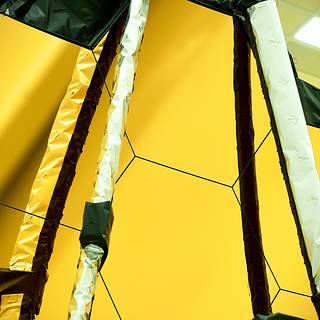Blue Origin eyes participation in military ‘rocket cargo’ program
Wednesday, 20 October 2021 19:34
Blue Origin is considering entering a cooperative agreement with the U.S. military to examine how space vehicles might be used to transport cargo around the world.
Rodolphe Belmer to step down as Eutelsat CEO in 2022
Wednesday, 20 October 2021 19:07
Rodolphe Belmer plans to step down as Eutelsat’s CEO at the beginning of 2022 after six years with the French satellite operator.
NASA challenges K-12 students to design moon-digging robots
Wednesday, 20 October 2021 18:38
NASA seeks young engineers to help design a new robot concept for an excavation mission on the Moon. The Lunabotics Junior Contest is open to K-12 students in U.S. public and private schools, as well as home-schoolers.
The competition, which is a collaboration between NASA and Future Engineers, asks students to design a robot that digs and moves lunar soil, called regolith, from an area of the lunar South Pole to a holding container near where Artemis astronauts may explore in the future.
As part of the Artemis program, NASA will land the first woman and first person of color on the Moon and establish long-term lunar science and exploration capabilities that will serve as a springboard for future exploration of Mars. Lunar regolith is instrumental in this development and could be used to create lunar concrete, reducing the amount and cost of materials that need to be transported from Earth.
To enter the contest, students must submit entries, which must include an image of the robot design and a written summary explaining how the design is intended to operate on the Moon, by Jan.
Connecting the Dots | Crowded orbits pose new security threats
Wednesday, 20 October 2021 18:12
Cybersecurity threats are a growing concern for day-to-day life on Earth. As thousands of satellites are launched to orbit, are there new risks to consider in the skies above?
NASA Shares Webb Telescope Media Briefing Schedule, Resources
Wednesday, 20 October 2021 16:00 NASA will hold a series of virtual media briefings and events leading up to the launch of the James Webb Space Telescope, the premier space science observatory of the next decade.
NASA will hold a series of virtual media briefings and events leading up to the launch of the James Webb Space Telescope, the premier space science observatory of the next decade. Rhea Space Activity to develop cislunar space ‘dashboard’ for U.S. Air Force
Wednesday, 20 October 2021 13:54
The U.S. Air Force has extended a research contract with startup Rhea Space Activity to develop a software tool to monitor and predict the trajectory of satellites in cislunar space.
From space traffic awareness to space traffic management
Wednesday, 20 October 2021 13:02
The term “space traffic management” (STM) inevitably triggers comparisons to air traffic management. The reality is far different.
Meet the winners of two ESA competitions at the IAC 2021
Wednesday, 20 October 2021 13:01
Ten start-up companies and SMEs secured the top places in ESA’s 2020 start-up competition and the Agency’s 2021 Global Space Markets Challenge.
Image: Auroras viewed from orbit
Wednesday, 20 October 2021 12:01
Auroras make for great Halloween décor over Earth, though ESA astronaut Thomas Pesquet snapped these green smoky swirls of plasma from the International Space Station in August. Also pictured are the Soyuz MS-18 "Yuri Gagarin" (left) and the new Nauka module (right).
The Station saw quite some aurora activity that month, caused by solar particles colliding with Earth's atmosphere and producing a stunning light show.
Fast forward to October and space is quite busy.
On 9 October the sun ejected a violent mass of fast-moving plasma into space that arrived at Earth a few days later. The coronal mass ejection (CME) crashed into our planet's magnetosphere and once again lit up the sky.
CMEs explode from the sun, rush through the solar system and while doing so speed up the solar wind—a stream of charged particles continuously released from the sun's upper atmosphere.
While most of the solar wind is blocked by Earth's protective magnetosphere, some charged particles become trapped in Earth's magnetic field and flow down to the geomagnetic poles, colliding with the upper atmosphere to create the beautiful Aurora.
Studying the edge of the sun's magnetic bubble
Wednesday, 20 October 2021 11:56
Our corner of the universe, the solar system, is nestled inside the Milky Way galaxy, home to more than 100 billion stars. The solar system is encased in a bubble called the heliosphere, which separates us from the vast galaxy beyond—and some of its harsh space radiation.
We're protected from that radiation by the heliosphere, which itself is created by another source of radiation: the sun. The sun constantly spews charged particles, called the solar wind, from its surface. The solar wind flings out to about four times the distance of Neptune, carrying with it the magnetic field from the sun.
Senate appropriators frustrated with lack of progress on civil space traffic management
Wednesday, 20 October 2021 10:13
Senate appropriators, frustrated with the lack of progress by the Commerce Department on space traffic management, are threatening to withhold other funding until it gets detailed plans from the agency.
Humidity caused corrosion of Starliner capsule valves, Boeing, NASA say
Wednesday, 20 October 2021 09:56 Humid Florida air may have caused valves to stick in Boeing's Starliner space capsule during preparation for a test launch Aug. 3, causing further delay in NASA's astronaut launch program, the company and NASA announced Tuesday.
The capsule, already four years behind schedule at a development cost of $4.6 billion, may not be launched again until early 2022 as the valve investigation con
Humid Florida air may have caused valves to stick in Boeing's Starliner space capsule during preparation for a test launch Aug. 3, causing further delay in NASA's astronaut launch program, the company and NASA announced Tuesday.
The capsule, already four years behind schedule at a development cost of $4.6 billion, may not be launched again until early 2022 as the valve investigation con Laser Communications Relay Demonstration gears up for launch
Wednesday, 20 October 2021 09:56 NASA's Laser Communications Relay Demonstration (LCRD) is gearing up for launch this fall, no earlier than Nov. 22. The payload arrived in Florida in May, fully integrated into its host spacecraft and ready for its final testing before being lofted into space.
LCRD will leverage the power of infrared light to send and receive information encoded into invisible laser beams from one location
NASA's Laser Communications Relay Demonstration (LCRD) is gearing up for launch this fall, no earlier than Nov. 22. The payload arrived in Florida in May, fully integrated into its host spacecraft and ready for its final testing before being lofted into space.
LCRD will leverage the power of infrared light to send and receive information encoded into invisible laser beams from one location IU physicists lead world's most precise measurement of neutron lifetime
Wednesday, 20 October 2021 09:56 An international team of physicists led by researchers at Indiana University has announced the world's most precise measurement of the neutron's lifetime.
The scientific purpose of the experiment, which IU has led for over a decade, is to measure how long, on average, a free neutron lives outside the confines of atomic nuclei.
The results from the team, which encompasses scientists f
An international team of physicists led by researchers at Indiana University has announced the world's most precise measurement of the neutron's lifetime.
The scientific purpose of the experiment, which IU has led for over a decade, is to measure how long, on average, a free neutron lives outside the confines of atomic nuclei.
The results from the team, which encompasses scientists f Samples from China mission show Moon 'active' more recently than thought
Wednesday, 20 October 2021 09:56 The first lunar rocks brought back to Earth in decades show the Moon was volcanically active more recently than previously thought, Chinese scientists said Tuesday.
A Chinese spacecraft carried lunar rocks and soil to Earth last year - humanity's first mission in four decades to collect samples from the Moon, and a milestone for Beijing's growing space programme.
The samples included ba
The first lunar rocks brought back to Earth in decades show the Moon was volcanically active more recently than previously thought, Chinese scientists said Tuesday.
A Chinese spacecraft carried lunar rocks and soil to Earth last year - humanity's first mission in four decades to collect samples from the Moon, and a milestone for Beijing's growing space programme.
The samples included ba 